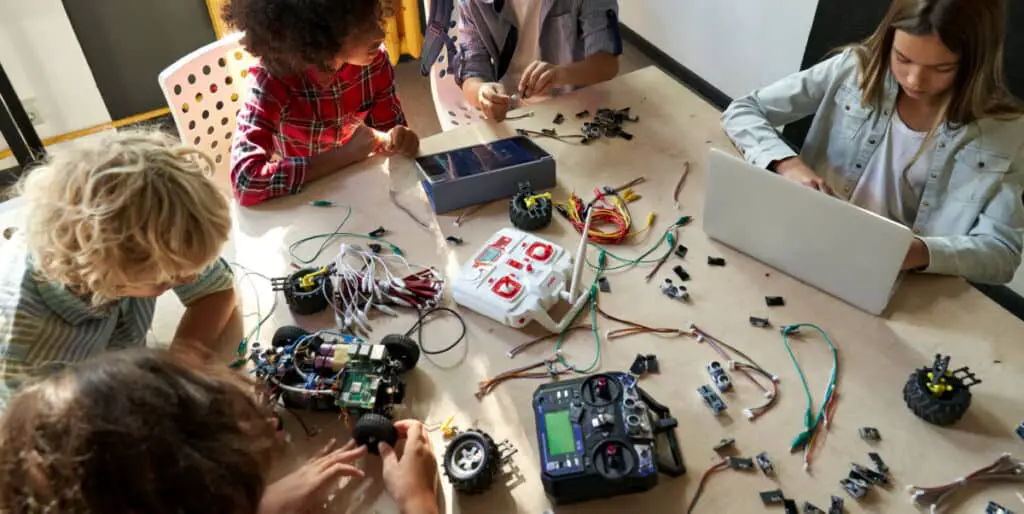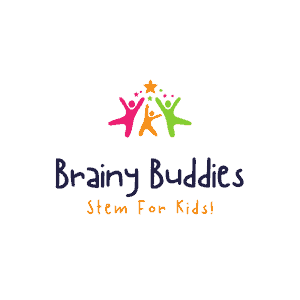Imagine a school where new, modern, and unique technology replaces books, notebooks, and all that traditional stuff. Wouldn’t you be amazed and more interested in learning a subject?
Exactly!
That’s how STEM schools are different from traditional schools. Forget the boring science, math, and chemistry classes with all those complicated diagrams and functions. STEM classes will make you love these subjects, even if you do not like them. That’s a significant advantage that STEM schools offer to their students.
So, this is our topic for today. Let’s delve into the distinctive qualities of STEM schools that set them apart from conventional educational institutions, making them exceptional and exciting.
Stay tuned until the end of this article to learn more about how STEM schools differ from traditional schools.
Table of Content
- What Are STEM Schools?
- What Are Traditional Schools Education?
- 10 Reasons STEM Schools Are Different From Traditional Education
- Frequently Asked Questions
- Conclusion
What Are STEM Schools?

Understanding the advantages and characteristics of Science, Technology, Engineering, and Math (STEM) schools is essential to understanding what STEM schools are.
These schools design their curriculum to provide all the essential information for the subjects through interactive ways using technology, creative materials, and critical thinking to solve problems.
However, the way STEM schools switch things up makes them unique. Science, technology, engineering, and math are not isolated fields.
They combine them all together to create a mixture that has connections throughout. It’s similar to having a broad perspective, perceiving the connections between many areas, and appreciating that true innovation occurs at these intersections.
STEM schools help you understand and learn practical subjects by experimenting, thinking, and practicing while using innovative technology and techniques. These are the reasons STEM schools are often related to intelligent students.
What Are Traditional Schools Education?

Traditional education typically expects well-worn books on your grandparents’ bookshelves steeped in history and time. The conventional subjects—mathematics, science, language arts, social studies, and a hint of the arts—take center stage in these institutions.
Imagine a standard classroom:
- Pupils hopping from one topic to the next
- A teacher at the front imparting wisdom
- Rows of desks
We’ve have been familiar with this system for a long time, where learning typically consists of listening to lectures and reading textbooks. Every class has a designated instructor who leads the students through their areas of expertise; examples include languages, science, math, geography, and chemistry.
Textbooks are reliable guides, and exams are the usual way to make assessments. In summary, traditional education and schools provide general knowledge to students, allowing them to know a little about everything.
10 Reasons STEM Schools Are Different from Traditional Education

It’s crucial to understand the differences between the two because many people need clarification and need to know the exact differences.
When STEM comes into the conversation, we mainly think about something interesting, unique, and innovative. That’s why they are different from today’s traditional schools.
However, these reasons are not the only ones that make STEM schools unique. There are many other reasons STEM schools have differences; we will analyze them all below.
Here are the top ten reasons that STEM schools are different from traditional schools:
Curriculum Emphasis
The first and the most important is that STEM schools prioritize STEM subjects in their curriculum. These subjects are frequently integrated across disciplines, providing a holistic approach to learning.
The curriculum’s focus in STEM schools is a great combination or mixture of subjects that prepare you for real-life situations, not just the upcoming exams.
Learning how to view the world through the lenses of science, technology, engineering, and mathematics is just as important as knowing the content.
A specialized and specific curriculum where each lesson serves as a stepping stone to becoming a knowledgeable STEM explorer of the real world.
Project-Based Learning
STEM education shares hands-on, project-based learning. Students solve real-world issues by applying scientific ideas, mathematical concepts, and engineering abilities.
Developing critical thinking is the most underrated skill people ignore nowadays. Thinking outside the box will help you be different from most people as you will provide unique solutions to problems and be more productive.
So, what is one of the most incredible things STEM schools offer?
Projects. No more snoring through abstract concepts. You are the innovator and the problem-solver in STEM education.
Imagine yourself developing a robot, creating a sustainable energy source, or learning how to code a ground-breaking program.
Building something from scratch that you would be proud of in the future is genuine, interactive, and fantastic!
Technology and Innovation Integration
In today’s fast-paced world, STEM schools leverage advanced technology, providing students access to cutting-edge tools, laboratories, and equipment to enhance their learning experiences.
Students learn how to use advanced technology that will help them improve productivity, skills, and knowledge on how to produce, edit, or analyze something.
It also serves as your partner in crime, not just something to impress. You may acquire access to the newest devices and software by attending a STEM school. It’s similar to possessing superpowers that enable you to realize your most imaginative dreams. The classroom serves as both your creative playground and a place to study.
Of course, this technology is only available in some traditional schools, which is a primary advantage of STEM schools compared to traditional ones.
Specialized and Experienced Teachers
Teachers at STEM schools are usually skilled in teaching STEM courses since they have received specialized training and much experience in these fields.
Experienced teachers are a must because when you have to deal with innovative technology and new learning methods, you need experienced professors to help you get the most out of each subject.
This is a significant disadvantage in traditional schools because some teachers are unfamiliar with advanced technology, so students cannot experience this kind of technology.
Career Preparation
STEM schools strive to educate students for employment in STEM-related disciplines by providing hands-on experiences, industrial relationships, and exposure to real-world STEM applications. This focus on real-world applications is a vital benefit of STEM schools.
After all, these institutions prioritize the future of their students, aiming to ensure successful careers for them.
On the other hand, most traditional schools do not pay the same attention to their students, which is a negative aspect for the schools and society in general.
So, this is another difference between these two types of schools. According to Graham Bell, a great quote that genuinely fits this situation is, “Preparation is the key to success.”
Creativity and Innovation
We mention that in the beginning, and we will repeat it. STEM schools are known for their creativity and innovation as they focus on making subjects more interactive to capture students’ attention.
STEM schools understand that their students need to be more engaged by boring traditional education that has been around for decades. Instead, they include you in the action. In a real lab, you’re creating experiments rather than just reading about science in theory.
Math is a puzzle you put together to answer issues in the real world, not just equations written on a board.
In addition, let’s talk about something other than technology; it’s about more than just utilizing it; it’s also about producing with it and getting real-time results.
Flexible Learning Environment
These locations have already proven to function as hubs for creativity. Similarly, the adaptability of the learning environment acts like the magic component that stimulates creativity.
Imagine this: When you enter a STEM classroom, the usual arrangement of desks facing the front is not there. Nope, it’s more akin to a place made to accommodate whatever exciting event occurs that day. Do you require a cooperative workstation for a team project?
Are you up for a practical experiment? It turns the space into a research lab. The classroom is a miraculous shape-shifting machine that adjusts to accommodate each excellent educational opportunity.
Real-World Applications
Let’s discuss the real-world magic in STEM institutions, where learning focuses on applying all that brainpower in real-world applications rather than merely acing exams.
Imagine being able to predict climate change using numbers rather than just crunching them in a vacuum. We’re talking about a real-world application vibe like that.
STEM schools reject the idea of confining knowledge to the four walls of the classroom. They prefer that you apply what you learn to the world at large.
Thus, you may find yourself in a science class where you learn about cells and how this information can result in medical advancements. It’s about coming up with answers to environmental issues rather than learning chemical formulas.
Team Collaboration
Students are encouraged to make connections between science, technology, engineering, and mathematics through collaborative projects at STEM schools. As a result, they become ready for the interdisciplinary demands of STEM careers.
Teamwork in STEM education is a mindset rather than merely a tactic. It’s about fostering an understanding that, in the ever-changing field of STEM, a team’s collective power frequently exceeds the sum of its members’ efforts.
It’s an essential skill set that enhances education and establishes the groundwork for success in the collaborative world of STEM employment.
Of course, the challenges and complexity of STEM subjects force students to collaborate in several ways.
Integration of Arts and Humanities
The integration of arts enables multifaceted expression. Pupils can add a creative element to their scientific pursuits by using artistic mediums, such as visual aids, narratives, or performances, to depict complex scientific concepts.
STEM schools integrate the humanities and arts beyond traditional educational limits. It enhances the educational process, fosters creativity, and gives students the multidisciplinary skills they need to succeed in a world that requires both technical know-how and a profound comprehension of the complexity of people.
It’s vital to develop thinkers and innovators who can have a beneficial influence on the world in addition to producing scientists and engineers.
Frequently Asked Questions

How Do STEM Schools Prepare Students for Life After Graduation?
STEM schools emphasize how STEM topics are applied in the real world, preparing students for life after school. Emphasizing real-world applications promotes a practical grasp of these subjects through projects, internships, industry partnerships, and exposure to STEM careers.
Are After-School Programs Typical in STEM Schools?
Yes, extracurricular involvement is a usual phenomenon that occurs at STEM schools. Some examples could be science fairs, math competitions, robotics clubs, or other activities that inspire students to delve deeper into STEM subjects outside the classroom.
What is Project-Based Learning in STEM Schools?
Project-based learning in STEM schools usually includes students working on projects based on reality to solve problems and applying concepts from technology, science, engineering, and mathematics in practical cases. It focuses on hands-on experience and critical thinking. STEM schools always want to make their students think outside the box to find a solution or a way to overcome a problem.
Conclusion
STEM schools stand apart from traditional schools in significant ways. They transform education into an immersive endeavor where subjects come alive, fostering active learning instead of passive knowledge absorption.
Unlike conventional schools, which focus mainly on information delivery, STEM schools prioritize hands-on projects, teamwork, and real-world applications, bridging the gap between theory and practice.
This shift in approach marks a fundamental change as STEM education prepares students for a future demanding creativity, adaptability, and a deep understanding of interconnected information, going beyond mere exam preparation!


